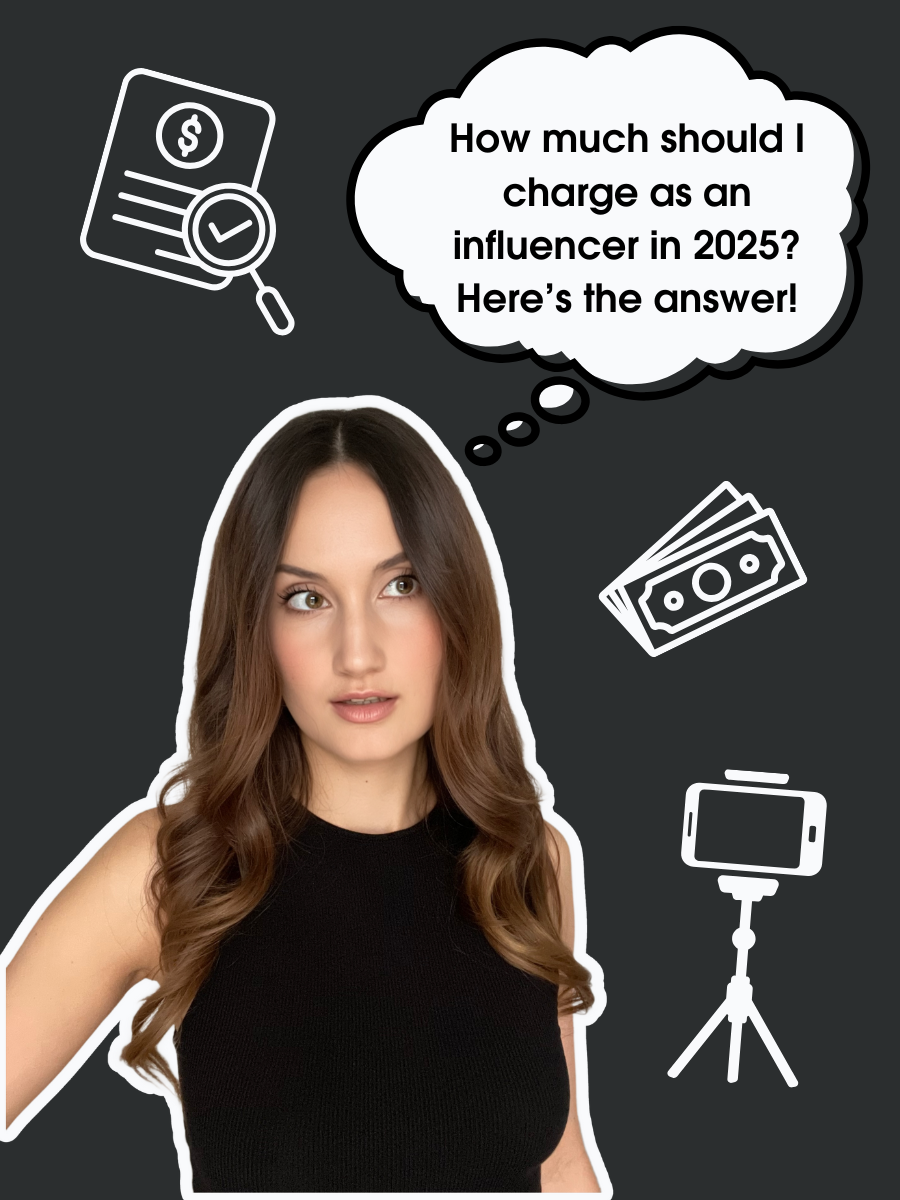How Much Should I Charge as an Influencer in 2025? 15 Factors That Boost Your Rates (+ Example Calculator)
Wondering, “How much should I charge as an influencer?” You’re not alone — it’s one of the biggest questions every creator faces. And here’s the short answer: there isn’t one flat fee. Your rate depends on a mix of audience size, engagement, niche, and more — but once you know the factors, you can confidently set prices that actually reflect your value.
As a lawyer who drafts influencer contracts daily, I’ve seen too many creators either underprice themselves or get pressured into rates that don’t cover their worth. That’s why I created this guide — to walk you through the 15 crucial factors that decide your rates in 2025, from nano influencer rates to mega-influencer rates, and show you how to calculate them step-by-step.
👉 Want a shortcut? Grab my free influencer rate card — it’s the exact tool you can use to map out your rates and present them professionally to brands.
By the end of this post, you’ll not only know how to answer, “How much should I charge as an influencer?” but also how to maximize every deal with confidence.
This post is all about the crucial factors to boost your income (including an example calculation) to answer the question, “How much should I charge as an influencer?”.
How much should I charge as an influencer?
Grab the FREE Influencer Rate Card Template First!
Before we dive into all 15 factors, here’s the shortcut: you don’t need to build your rate card from scratch. I’ve already done the heavy lifting for you.
👉 Download my free Influencer Rate Card (available instantly in my free legal library).
With it, you’ll:
See how to structure your rates clearly for brands.
Factor in add-ons like usage rights, revisions, and rush fees.
Avoid underpricing yourself — one of the biggest mistakes I see influencers make.
Use it alongside this guide to confidently answer, “How much should I charge as an influencer?”
Now, let’s dive into the 15 factors that boost your influencer rates!
1. General base rates by audience size
The first step in answering “how much should I charge as an influencer?” is to look at general base rates by audience size, from nano influencer rates to mega influencer rates. While not the full picture, this benchmark helps you anchor your pricing before layering in other factors.
Typical base rates in 2025:
Nano influencers (1,000–10,000 followers): $10–$100 per post
Micro influencers (10,000–50,000 followers): $100–$500 per post
Mid-tier influencers (50,000–100,000 followers): $500–$1,000 per post
Macro influencers (100,000–1,000,000 followers): $1,000–$10,000 per post
Mega influencers (1M+ followers): $10,000+ per post
💡 Pro tip: These numbers are just a starting point. If you stop here, you risk underpricing yourself. That’s why you need to combine this with the other 14 factors below.
👉 Want a done-for-you way to plug in these numbers? My free influencer rate card template gives you a ready-made template to start calculating.
2. Market rates for your niche
Not all niches are valued the same. A finance creator with 20k followers can often charge double or triple what a fashion creator with the same audience can, simply because financial brands have higher budgets and higher customer lifetime value.
On the flip side, if you’re in a saturated niche like lifestyle or beauty, you’ll often need to compete on creativity, engagement, and add-ons to justify higher rates.
💡 Research what influencers in your niche — with similar follower counts and engagement — are charging to get a good understanding of influencer marketing pricing in your niche. Then position yourself at the right end of the spectrum.
👉 Don’t want to spend hours researching? My free influencer rate card template already factors in these niche differences, so you can adjust your pricing with confidence.
3. Engagement rate
To answer the basic question of “How much should I charge as an influencer?”, your base rate should then be adjusted based on your engagement rate.
Engagement is one of the biggest credibility markers brands look at. If you have 20k followers but barely 100 likes, your rate will plummet. But if you have the same audience size with 5–10% engagement, you can (and should) charge more than average.
Example: If your engagement rate is 5% on Instagram, you could increase your base rate by 20% without pushback — because you’re delivering more value per follower.
👉 High engagement is your leverage. Show it clearly in your influencer fees (yes, I include a section for this in my free influencer rate card template).
4. CPE (Cost Per Engagement)
The next step in answering “how much should I charge as an influencer?” is to determine your CPE. Brands don’t just care about your follower count — they care about what your followers actually do. That’s where CPE (Cost Per Engagement) comes in.
CPE shows the value of every like, comment, or share. For example:
If you average 1,000 likes/comments per post
And you charge $0.50 per engagement
Your rate = $500 per post
💡 If your engagement is strong, highlight your CPE on your rate card. It’s an easy way to justify higher rates and stand out from influencers who only pitch based on follower count.
👉 My free influencer rate card template includes a section where you can show your engagement stats in a brand-friendly way.
5. Average views & impressions per post (CPM)
Even with a smaller audience, high impressions and views can boost your rates. This is where CPM (Cost Per Mille)comes in — the cost per thousand impressions.
Example calculation:
Average 100,000 impressions per post
CPM = $20
Base rate = (100,000 ÷ 1,000) × $20 = $2,000
💡 CPM is a universal language between influencers and brands. If you can show a strong CPM, brands instantly see the value in your rates.
6. Conversion rate or ROI
The next step in answering “how much should I charge as an influencer?” is to calculate your conversion rate or ROI.
Once you’ve worked with a few brands, you’ll have something even more powerful than engagement or impressions: proof of ROI (Return on Investment).
If you can show that 5% of your audience converted into paying customers for a brand, you can justify increasing your rates by 20% or more. Brands are willing to pay premium rates if you can prove you make them money.
💡 Even just one or two screenshots of results (with the brand’s permission) can massively strengthen your negotiating power.
👉 My free influencer rate card template has a section for showcasing ROI/conversion highlights, so you can add credibility when pitching your rates.
🎁 Want to Save Hours Figuring Out Your Rates?
You don’t have to calculate everything from scratch.
👉 Download my free Influencer Rate Card (available when you subscribe to my newsletter) and get a ready-made template you can use today.
With it, you’ll:
See exactly how to structure your rates for brands.
Showcase engagement, CPM, ROI, and add-ons clearly.
Avoid underpricing yourself — and start charging confidently.
Use it alongside this guide to make your pricing crystal clear and brand-ready.
7. Audience demographics
Not all followers are equal. Brands pay more when your audience matches their ideal customer profile.
Example: If most of your followers are young professionals with disposable income, a financial services brand will happily pay more than a local boutique with limited budgets.
💡 The closer your audience demographics align with a brand’s target, the higher your value.
👉 My free influencer rate card template includes space to highlight key demographics so brands instantly see why your audience is worth the investment.
8. Type of platforms
When asking “how much should I charge as an influencer?”, you also need to take into account differences in social media platforms.
Rates differ by platform because audience behavior differs. An Instagram Reel might command a higher rate than a single tweet, and a YouTube integration could be worth several times more because of longevity and SEO.
💡 Don’t sell yourself short. Always price based on platform strength + effort, not just follower count.
👉 Use my free influencer rate card template to separate your platform-specific rates so brands can see the difference clearly.
9. Content type
The type of content also affects your rate. A polished YouTube video requires more prep, filming, and editing than a single Instagram Story. Similarly, a TikTok with transitions and music is more work than a simple static post.
💡 The more effort and skill required, the higher your rates should be.
👉 Inside my free influencer rate card, you’ll find sections to break down pricing by content type — so brands understand why a video post costs more than a photo.
10. Number of content pieces
When a brand asks for multiple posts, they’ll expect a discount. More posts = more work for you, but also more stability in income.
Example: 5 Instagram posts over 2 months at a 10–20% discount. This creates a win-win: the brand gets bulk value, and you lock in more guaranteed income.
💡 Structure these package deals clearly so you don’t get taken advantage of.
👉 My free influencer rate card template includes a section with influencer rates for multi-post bundles so brands know exactly what they’ll pay (and what discount they get).
11. Rush fee
Sometimes brands need content yesterday. Whether it’s for a campaign launch or a last-minute promo, you’re rearranging your schedule — and that deserves compensation.
💡 Add a rush fee (e.g., +20% for turnaround within 48 hours). That way, urgent projects feel worth your time.
👉 My Brand Sponsorship Contract Template spells out rush fees in writing, so brands can’t argue when you add them.
12. Revisions
When asking “how much should I charge as an influencer?”, you also need to take into account the amount of work that you invest into a specific project, e.g., the number of revision rounds involved.
Revisions are one of the biggest time drains in influencer partnerships. Without boundaries, brands can keep asking for changes until your hourly rate is pennies.
That’s why you must clearly state:
How many revisions are included in your base rate.
What additional revisions cost.
💡 Protect yourself here — it’s not just about rates, it’s about respecting your time.
👉 My free influencer rate card template lets you set a limit on included revisions, while my Brand Sponsorship Contract Template locks those terms in legally.
13. Geographical location
Your location (and the brand’s) can influence your rates. Cost of living, local budgets, and even the prestige of a market matter.
Example: A New York hotel may pay more than a small countryside inn, even for the same post, because its marketing budget is larger.
💡 Always consider where both you and the brand are based when negotiating rates.
👉 My free influencer rate card template gives you a framework to adjust pricing for location so you don’t leave money on the table.
14. Market conditions
Economic climate plays a big role in ad budgets. In booming times, brands spend more. In downturns, influencer budgets are often the first to shrink.
💡 Keep your rates flexible. Review them at least once a year to reflect current conditions.
👉 With my free influencer rate card template, you can update your numbers quickly without having to redo your whole structure.
15. Long-Term Partnerships
There’s one last factor that you should take into consideration when answering the question, “How much should I charge as an influencer?”
One-off campaigns are great, but long-term deals are better. If a brand sponsors you regularly, offer a small discount (say 10%). It shows goodwill and keeps them coming back.
💡 That stability is worth more than a one-time full rate.
👉 My Brand Sponsorship Contract Template includes clauses for long-term deals, so you’re protected while building recurring income.
📌 Ready to Make Pricing Easy?
Instead of juggling spreadsheets or guessing what to charge (and asking “How much should I charge as an influencer?” over and over again), you can use my free Influencer Rate Card Template to structure everything in one place.
With it, you’ll:
Showcase your engagement, CPM, ROI, and demographics professionally.
Add clear sections for revisions, rush fees, and packages.
Update your pricing instantly as your influence grows.
👉 Subscribe to my newsletter today and get the free influencer rate card template delivered straight to your inbox.
Let’s Calculate Your Rates: How Much Should I Charge as an Influencer Calculator
Now that you know the 15 factors, let’s put it all together.
Imagine you’re a micro-influencer on Instagram with 50,000 followers. Here’s how your rate could be calculated step by step:
Step 1: Base Rate (using CPM)
Formula: (Followers ÷ 1,000) × CPM
Calculation: (50,000 ÷ 1,000) × $20 = $1,000
Step 2: Adjust for other factors
Niche/market adjustment: +10% ($100)
High engagement rate: +20% ($200)
High ROI: +20% ($200)
Long-term partnership discount (5 posts): −10% (−$100)
Usage rights for 1 year: +30% ($300)
Step 3: Adjusted rate
$1,000 + $100 + $200 + $200 − $100 + $300 = $1,700–$1,800 per post
💡 This is why there’s no single answer to “how much should I charge as an influencer?” — it depends on the unique mix of factors you bring to the table.
👉 Want to skip the math? My free influencer rate card does the heavy lifting for you. Just plug in your numbers and you’ll have a professional, brand-ready rate card in minutes.
Why a Contract Is Just as Important as Your Nano Influencer Rates
Getting the answer to “how much should I charge as an influencer?” is only half the battle.
To actually protect your income, you need those rates (and extras like revisions, rush fees, and usage rights) written into a contract. Otherwise, brands can push boundaries, and you’ll be left unpaid for your time.
That’s why I created my Brand Sponsorship Contract Template — designed specifically for influencers. It covers:
Clear payment terms (so you actually get paid on time).
Revision limits, rush fees, and cancellation rules.
Usage rights, exclusivity, and long-term partnership clauses.
Legal protections to keep your income secure.
👉 You can grab it here in my contract shop and pair it with your rate card to maximize your income and protect your boundaries.
Conclusion: Charge What You’re Worth and Protect Your Influencer Rates
By now, you know the answer to “How much should I charge as an influencer?” — it’s not a single number but a calculation based on 15 key factors. When you price strategically, you stop leaving money on the table and start charging rates that reflect your true value.
👉 Step one: Download my free influencer rate card to build your own brand-ready pricing sheet in minutes.
👉 Step two: Protect those rates with my Brand Sponsorship Contract Template, so your payment terms, revisions, and usage rights are legally locked in.
This combo ensures you’re not just setting the right price — you’re actually getting paid and keeping control over your work.
This post was all about answering “How much should I charge as an influencer?” and the 15 factors to boost your influencer rates.
🔗 Want to dive deeper?






